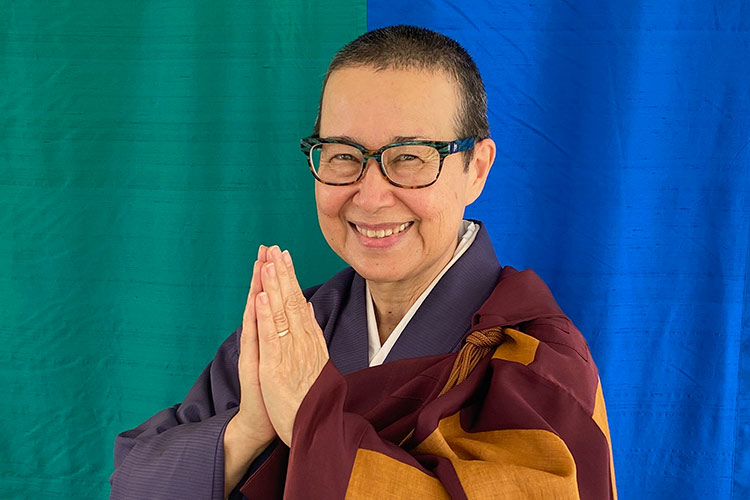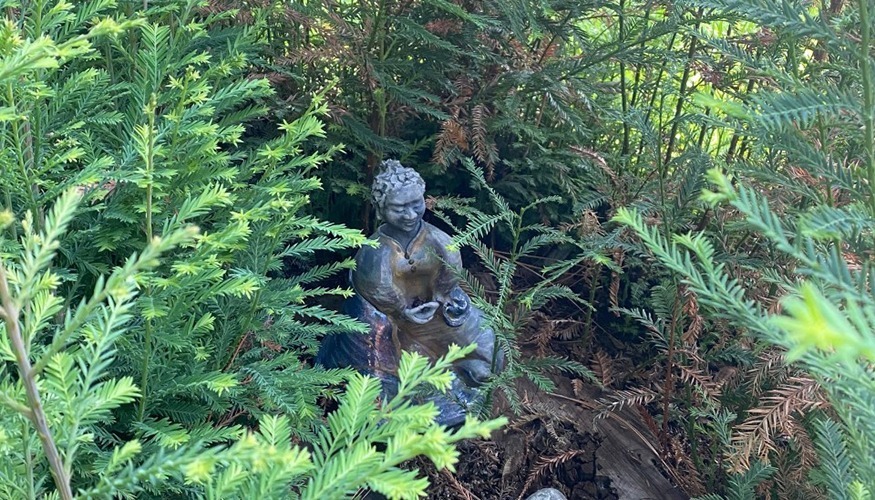
The New Year à la Diamond Sutra
January 1, 2021
by Wendy Egyoku Nakao
We turn the proverbial calendar page and voila, here we are in 2021. When, in fact, there is no old or new year. There is just now! What we call our life—what we call time—is beginningless and endless. It is as the Diamond Sutra sets forth: “What I call ‘the new year’ is not ‘the new year.’ Such is merely a name. That is why I call it ‘the new year.’ ”
Maezumi Roshi was fond of saying that it is helpful to place a punctuation mark in this life of no beginnings and no endings. What mark will you place as we measure our days by the Gregorian calendar? Will you place a period, a comma, a hyphen, a semi-colon, an exclamation point or perhaps a question mark? I am partial to the long dash. After a tough ten months, we are all likely breathing a sigh of relief at the custom of ringing out the old and ringing in the new, even if nothing has really changed and the pandemic rages on in Los Angeles.
The Diamond Sutra expounds a useful formula for living awake. It expounds the sound Buddhist logic of “p is not p, that is why I call it p.” Or, “What I call (such and such), is not (such and such). Such is merely a name. That is why it is called (such and such).” I recommend using this formula, which can cut through the knots of the mind like a diamond sword and align you with the dynamic life force itself. Even if you don’t fully understand this formula, using it will loosen up your grip on whatever you are clinging to, even just a little bit.
In the Diamond Sutra, the Buddha teaches Subhuti as follows, “…what the Tathagata has called a conception of dharmas is not a conception of dharmas. Such is merely a name. That is why it is called a conception of dharmas.” There is nothing that is exempt from this formula. Maezumi Roshi often used the adjective “so-called,” as in so-called new year, so-called Dharma, or so-called pizza. This is a fine way to remember that the designation of a name is not the thing itself. It merely points to the pulsing reality that is obscured by the name we have agreed to call it.

This formula reveals the three legs of the path of a Bodhisattva. I envision an offering bowl with three legs. What are these three? Wisdom, compassion, and skillful means. The first leg — “What is called ‘the new year’ is not ‘the new year,’ ” reveals the supreme wisdom of shunyata, the essential nature of being empty of any fixity. Reality is energy in motion; nothing is solid, nothing is fixed. All is constantly moving; this great rhythm of the life force moves unceasingly. We, too, are of this nature — never apart, never separate, but a direct expression of the very web of life itself. We are always in creation; we are always co-creators.
This ever-moving energy gathers itself into various forms. Owing to karmic and natural laws, each formation has its own unique characteristics, including how long its form will hold. A bubble in a stream holds its form for a few seconds, a butterfly for about thirty days, Rohatsu sesshin for seven days, a human being for anywhere from a few hours to over one-hundred years, a gingko tree for three thousand years, and a mountain for centuries. However long the form is held, the form itself is not solid even if it appears to be so. It is, in fact, empty of any fixity, of any fixed point.
Compassion, the second leg, is embodied in the phrase, “Such is merely a name.” Whenever I hear or say this phrase, my heart opens and softens a little. Compassion arises with seeing that what we perceive as our lives is solidified by language. Hence, what we live “is merely a name,” not the actual taste, sound, smell, or touch of direct experiences. What is this softening that I experience at these words?
First, I feel compassion for myself — for the fact that I have unnecessarily created a solid and separate sense of myself, people, and situations and attached to these self-generated ideas. I see how I have obscured the very nature of life with my thoughts, labels, and ideas that I then call “my life.” I experience the suffering this causes.
So you should view all of the fleeting worlds: A star at dawn, a bubble in a stream;
A flash of lightning in a summer cloud;
A flickering lamp, a phantom, and a dream.
Secondly, compassion arises within me for all those who do not see this diamond wisdom. When Siddhartha saw the morning star and awakened to the insubstantiality and connection of all forms, he refused to budge from his seat under the bodhi tree. He had resolved his urgent question about life for himself. For seven days he sat satisfied. During those days, compassion arose in him for all those who did not see what he saw; for all those who did not have the experience of being free from concepts, from ideas of a solid, fixed self-identity. He felt compassion for all those who were not free from the tyranny of their own thoughts and the thoughts of others; for all those who live with the ego-self as the sole reference point of their lives. Perhaps he especially felt compassion for those who sensed that there was something more — some way to be liberated from their suffering and had no idea how to be free.
The third leg, skillful means, is embodied in the final phrase of the formula, “And that is why we call it ‘the new year.’” Skillful means are the ways that you and I co-create to help each other see the diamond wisdom that Shakyamuni realized. What are the skillful means that will help us see through to shunyata? To see through to the arising of the myriad forms, which are, as the Sutra says, as numerous as the sands of the Ganges River. Each form has its own unique name, but it is only a so-called name. “And that is why I call it ‘the new year’” because I know the true nature of that which is called by a name.
If you were to consider everything you do as a skillful means, how would your life align with such a vision? The entire Zen Center is set up as a skillful means — sesshin, samu, giving talks, face-to-face, preparing and sharing meals, zooming, according with the precepts, and so forth. All are skillful means to align us with this reality of wisdom and of all-encompassing compassion. When we do this — no matter how small our understanding and effort, the very act of doing puts us in alignment with the universal life force. In this way, we can serve each other skillfully without any attachment to outcome because you and I align with the great benevolent movement of the life force that is itself a buddha being.
The Buddha asks, “In what spirit would [you] illuminate [the Sutra] for others?” The Buddha himself responds, “Without being caught up in the appearance of things in themselves but understanding the nature of things just as they are. Why?” In response, the Sutra ends with this memorable verse:
So you should view all of the fleeting worlds: A star at dawn, a bubble in a stream;
A flash of lightning in a summer cloud;
A flickering lamp, a phantom, and a dream.
This verse sums up the deep feeling that I have for this life, that the flavor of this mysterious life is bittersweet — beauty tinged with sadness.
Indeed, isn’t this the flavor of these pandemic days? In the midst of sorrow, suffering, and pain, we experience the incredible sweetness of people reaching out across balconies, saving lives in overwhelmed hospitals, and extending help to those suffering from the loss of lives and livelihood.
Roshi Egyoku is ZCLA’s Head Teacher. Quotes from Mu Seong’s translation of the Diamond Sutra. Article is excerpted from a teisho at Rohatsu sesshin, 2020.
